Comprehensive Kiteboarding Lessons in Fort Lauderdale
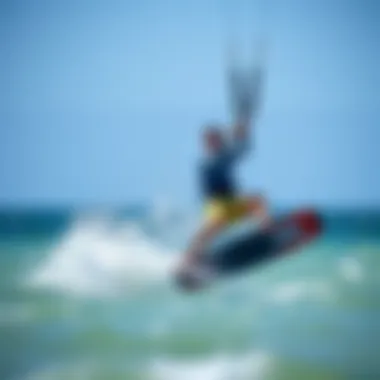
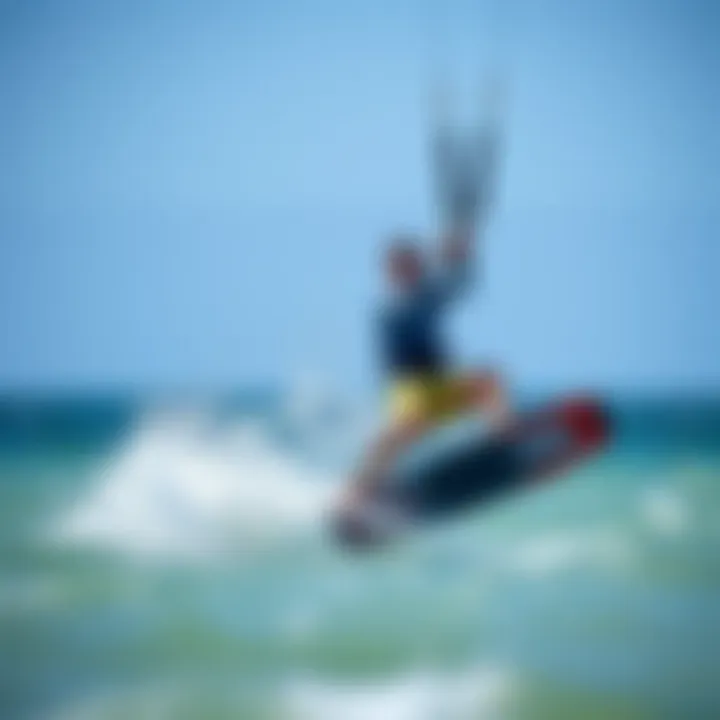
Intro
Kiteboarding, an exhilarating blend of surfing, sailing, and gymnastics, has found a welcoming home in Fort Lauderdale. This vibrant coastal city, kissed by the Atlantic waters, offers not just beautiful views but also ideal conditions for both budding kiteboarders and seasoned enthusiasts alike. With its stunning beaches, warm weather, and dynamic winds, Fort Lauderdale beckons those eager to learn or master the art of kiteboarding.
In this article, we will explore the ins and outs of kiteboarding lessons available in Fort Lauderdale, from foundational skills for newcomers to advanced techniques for those looking to refine their skills. Understanding the essential safety practices and appropriate gear is also crucial, ensuring you navigate both the sport and the waters safely. So, whether you’re a curious traveler, an aspiring athlete, or a dedicated coach, you’re in the right place as we unravel the world of kiteboarding in this spectacular setting.
Prelude to Kiteboarding
Defining Kiteboarding
Kiteboarding, at its core, integrates aspects of wakeboarding, windsurfing, and paragliding. It involves steering a board while harnessed to a large kite that propels riders across the water. The combination produces exhilarating thrust, enabling riders to catch waves and even perform aerial tricks. Kiteboarding can be enjoyed in various conditions, but the crucial factor that aligns all riders is the wind, which is what makes it possible to glide over the water effortlessly.
This sport necessitates a balance of skills—harnessing the wind’s power while maintaining control of the board becomes second nature with practice. A ride on a kiteboard can range from an exhilarating rush on an open sea to a gentle cruise down a serene coastline, depending on the rider's experience and wind conditions.
Origins and Evolution of the Sport
The roots of kiteboarding trace back to the beaches of Hawaii in the late 1970s. Early pioneers used kites to harness wind energy for surfing. Over time, this concept stayed afloat, evolving through the 80s and 90s as equipment improved and became more accessible. The first production kites, designed explicitly for the sport, appeared in the 1990s, enabling riders to seek new thrills and challenges.
By the turn of the millennium, diverse kite designs emerged, enhancing maneuverability and safety. The sport saw rapid growth across the globe, with enthusiasts flocking to coastal areas. Fort Lauderdale, with its strong winds and beautiful beaches, became a popular destination.
Through the years, kiteboarding has developed into a well-structured sport complete with teams, competitions, and dedicated organizations like the International Kiteboarding Association, which helps oversee events and promote safe practices among riders.
In summary, kiteboarding is not just a sport but a dynamic experience, combining physical skills and an affinity for nature. The journey from its humble beginnings to its current status as a global activity resonates with many who embark on this exciting venture in Fort Lauderdale.
Why Fort Lauderdale?
When it comes to choosing a location to learn kiteboarding, Fort Lauderdale stands out like a diamond in the rough. It's not just about riding the waves; it's about the complete experience that this vibrant city offers. From splendid weather to breathtaking scenery, Fort Lauderdale has become a haven for water sports enthusiasts. This section will help you understand why Fort Lauderdale is such a popular destination for kiteboarding lessons, detailing the specific factors that contribute to its top-tier status.
Ideal Weather Conditions
In Fort Lauderdale, the weather plays a pivotal role in the kiteboarding experience. You’ll find that this coastal city boasts a tropical climate that keeps conditions generally favorable throughout the year.
Average temperatures hover around a comfortable 75 to 85 degrees Fahrenheit, making it possible to learn and practice kiteboarding year-round. The wind conditions are particularly noteworthy; trade winds blow consistently, which is essential for kiteboarding. Typically, wind speeds range from 15 to 25 knots, creating an ideal setting for both novice and expert kiteboarders.
But it's not just wind and sun that make Fort Lauderdale a superb choice; it also has a minimal chance of unpredictable weather that can interrupt lessons. This means that kiteboarding schools in the area can offer classes with much more reliability than regions where weather is prone to sudden changes.
Here’s why the weather in Fort Lauderdale is ideal for learning kiteboarding:
- Consistent Winds: The area's reliable trade winds provide predictable conditions.
- Mild Temperatures: Warmer weather allows for comfortable sessions without the need for heavy gear.
- Long Kiteboarding Season: The extended favorable climate means less downtime for students.
Scenic Locations for Kiteboarding
When you hear the term "paradise," images of crystal clear waters and palm-fringed beaches often come to mind—and that's precisely what you get in Fort Lauderdale. The scenic locations here enhance the kiteboarding experience, turning each lesson into a mini adventure.
Hugh Taylor Birch State Park is one prime spot; with its serene waters, this park provides a perfect environment for beginners. The sheltered areas help in learning to control the kite without the worry of strong ocean waves. You could say it's the calm before the storm, but in this case, it’s just the perfect calm.
Fort Lauderdale Beach is another go-to location. Here, the buzzing atmosphere of beach-goers adds a social element to your lessons. Picture the bright blue ocean coupled with white sandy shores as your backdrop while you learn. The beach vibe makes for an energizing lesson environment, motivating you to push your limits.
- Cooper Beach: Ideal for advanced riders looking to catch bigger waves.
- Las Olas Intracoastal: A scenic waterway perfect for less experienced kiteboarders who want to avoid the open ocean.
The unique blend of gorgeous landscapes and varied water conditions makes kiteboarding in Fort Lauderdale not just a lesson but a full sensory experience. The beauty of these locales adds a remarkable layer to your learning progression, inspiring even the hesitant to take the plunge.
Kiteboarding in Fort Lauderdale is more than just a sport—it's an escape into the beauty of nature, backed by perfect wind and wave conditions.
Choosing Fort Lauderdale ensures not just skill development but also creates lasting memories that you'll cherish long after the lesson ends. Whether it’s the reliability of its weather or the stunning locales, Fort Lauderdale has solidified its reputation as an ideal destination for aspiring kiteboarders.
Types of Kiteboarding Lessons
Kiteboarding is not a one-size-fits-all adventure; it's a sport rich with varying levels of skill and expertise. Understanding the different types of kiteboarding lessons available in Fort Lauderdale is essential, whether you're just dipping your toes into the water or looking to refine your aerial maneuvers. These lessons cater to various needs, ensuring each participant gets the best out of their experience.
Beginner Lessons
For those who are new to kiteboarding, beginner lessons serve as the perfect launching pad. These sessions focus on the basics – understanding equipment, learning to control the kite, and practicing safety measures. Instructors usually structure these lessons to be as inclusive as possible, usually starting on land before hitting the waves. Techniques such as kite launching and landing, basic power control, and the significance of being aware of the surrounding environment come into play.
In beginner lessons, students often learn in calm waters, which helps them find their feet without overwhelming challenges. There tends to be a strong emphasis on practicing on small kite sizes, allowing students to get a feel for the winds and how the kite interacts with the water. It’s like learning to ride a bike with training wheels—development is gradual but purposeful.
"Starting with the basics is crucial. Because without a solid foundation, you'll struggle to build your skills."
Intermediate and Advanced Options
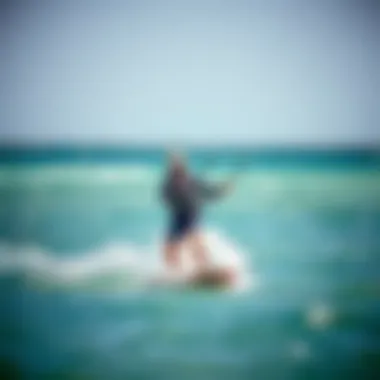
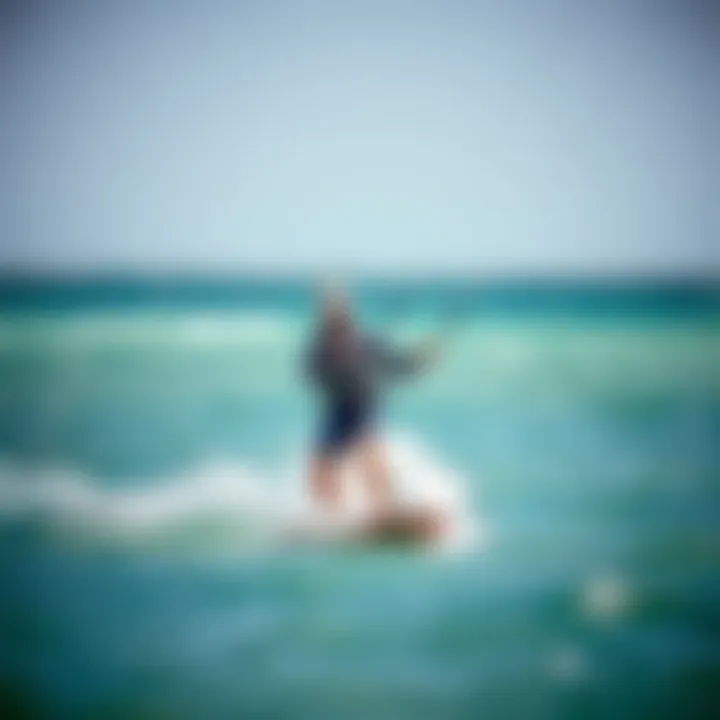
Once you’ve grasped the fundamentals, the journey continues with intermediate and advanced lessons. These options focus on refining skills and introducing more complex techniques. Students tackle skills such as navigating obstacles, jumping, and making sharp turns.
The instructors at this level challenge students to push their limits, often addressing individual goals and emphasizing performance enhancement. Students are encouraged to take calculated risks, honing their ability to read the conditions of the water and wind. These lessons are likely to navigate through different environments—ranging from flat water to choppy surfaces, which helps in versatile skill development.
Additionally, advanced lessons often include video analysis, giving participants a chance to review their performances critically. By examining techniques from different angles, kiteboarders can get precise insights into what works best for them.
Private vs. Group Lessons
When choosing between private and group lessons, it often boils down to personal preference and budget. Private lessons provide a tailored learning experience with one-on-one attention from the instructor. This format can fast-track skill acquisition, especially for those who thrive on personalized feedback and specific guidance. It’s akin to having a private coach who focuses solely on your pace and learning style.
In contrast, group lessons are fantastic for social interaction and often come with a more budget-friendly price tag. Participants learn in a supportive setting, sharing tips and encouragement, which can make the learning process feel less daunting. Group dynamics can stimulate camaraderie, making the learning experience more engaging and enjoyable. However, pace may vary, although many instructors are skilled in managing various skill levels within the same group.
Ultimately, understanding the types of lessons available lets aspiring kiteboarders find their fit in this thrilling sport. With the ideal lesson tailored to one’s skill level and preference, students in Fort Lauderdale can truly experience the joy and adventure that kiteboarding offers.
Choosing the Right Instructor
Selecting an appropriate instructor is one of the most essential steps in embarking on your kiteboarding adventure. The right teacher can make or break your learning experience, transforming it from a daunting challenge into an exhilarating journey. Not only does a skilled instructor instill foundational skills, but they also foster confidence and help you understand the nuances of the sport.
Qualifications and Experience
When it comes to kiteboarding, the qualifications and experience of your instructor matters immensely. Instructors should ideally be certified by recognized organizations. This ensures they have undergone proper training which covers both kiteboarding techniques and essential safety practices. For instance, the International Kiteboarding Organization (IKO) offers internationally recognized certification programs, which are testament to an instructor's capabilities.
However, certification alone isn't enough. Practical experience plays a vital role. A seasoned instructor has often dealt with all kinds of weather conditions and student challenges, making them more adept at customizing lessons to suit individual needs. A key point to consider is whether the instructor has experience teaching beginners specifically. Some instructors may excel at advanced techniques, but struggle when it comes to imparting basic skills to novices.
It's worth taking a step back and asking potential instructors about their background. For example, how many lessons have they taught? Have they worked with individuals similar to your skill level? Their answers will provide clarity not just on their experience, but on how well they can meet your learning needs.
Teaching Style and Methodologies
Beyond qualifications, an instructor's teaching style can have a significant impact on your experience. It's crucial to find a teacher whose methods resonate with you. Some instructors lean towards a highly structured approach, emphasizing theory before practice, while others might prefer a more hands-on style that fosters immediate engagement on the water.
Consider the dynamism of their teaching methods. Are they utilizing visual aids, perhaps showing videos of kiteboarding techniques? Or are they focusing on direct, real-time feedback as you practice? The latter can often help you progress more quickly as you'll have immediate correction and guidance, reducing the likelihood of developing poor habits.
Communication is also a key aspect. A good instructor should be able to explain complex concepts in simple terms. Look for someone whose instructions and feedback makes sense to you, and who encourages questions rather than dismissing them.
Ultimately, finding the right instructor is about a blend of qualifications, experience, and teaching methodologies. By taking the time to assess these factors, you’re setting yourself up for success as you embark on your kiteboarding journey.
"The quality of your instructor can define the trajectory of your kiteboarding journey, much like the wind guides a kite through the sky."
Useful Resources
Exploring your options wisely ensures that you receive the best foundation possible in this thrilling watersport.
Essential Gear for Kiteboarding
Kiteboarding is not just about gliding over the water and feeling the rush of the wind; it requires specific gear to ensure a successful and safe experience. Choosing the right equipment can make a world of difference in your performance, comfort, and safety on the water. In this section, we outline essential gear for kiteboarding, where we'll cover various kites, boards, accessories, and safety equipment.
Kites and Their Varieties
Kites serve as the heart of the kiteboarding experience. There are different types of kites designed for various conditions and styles. Understanding these varieties is crucial for selecting the right one for your needs.
- Leading Edge Inflatable (LEI): This popular type of kite consists of inflatable tubes that provide structure. They are forgiving and stable, making them suitable for beginners and experienced riders alike.
- Foil Kites: Unlike LEIs, these kites do not inflate but consist of fabric cells that catch air. They are lightweight and more efficient in lighter winds.
- Hybrid Kites: A combination of LEI and foil characteristics, hybrids are versatile and can perform well in both light and stronger winds.
Each type of kite brings unique benefits. For instance, LEIs are easier to relaunch after a crash, while foil kites are often lighter and more efficient.
Boards and Accessories
The board you choose is a critical factor in your kiteboarding success. Twin-tip boards are the most common, designed for riding in either direction. They are stable and generally a good option for beginners as they allow for easy upwind performance.
On the other hand, directional boards are designed for surfing-style riding and perform well in waves. Choosing the type of board often depends on your preferred riding style, conditions, and personal preference.
Accessories to consider include:
- Foot straps or boots: Provide a secure connection to the board. Straps are generally more prevalent for twin-tip boards, while boots offer better control for directional riding.
- Bar and lines: The control system is crucial for handling the kite. Ensure that the size matches the kite for optimal control and performance.
- Harness: A solid harness provides support and comfort while allowing you to steer the kite effectively. Choose between seat and waist harnesses based on comfort and riding style.
Safety Equipment
Kiteboarding, while exhilarating, carries inherent risks. Therefore, investing in safety equipment is non-negotiable. Essential safety gear includes:
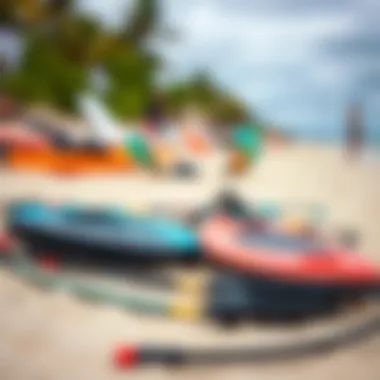
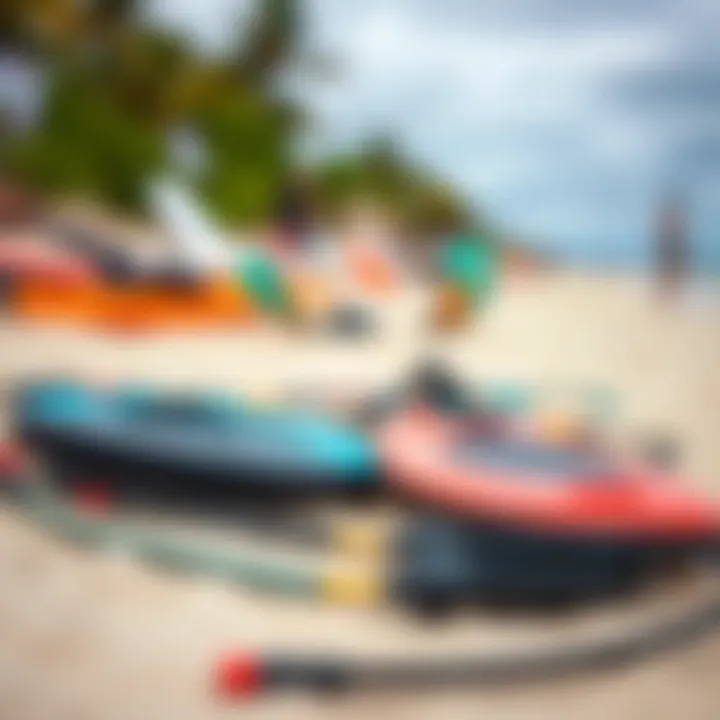
- Helmet: Protects your head from collisions and falls.
- Impact vest: Offers protection against impacts and adds buoyancy.
- Lifesaver buoy: A small buoy that allows you to stay afloat in case of emergencies.
- Quick-release leash: Helps you detach from the kite quickly should you find yourself in danger.
It's crucial to adhere to safety protocols while kiteboarding. This includes checking gear before hitting the water and ensuring you're familiar with safe practices based on local regulations and conditions.
Safety isn’t just gear; it’s understanding your limits and respecting the water.
Equipping yourself with the right gear significantly enhances your kiteboarding experience, paving the way for improved performance and safety. Whether you're a novice just hitting the waves or a seasoned pro, investing in quality gear tailored to your needs is a wise decision. Understanding your tools will not only make learning easier but will also foster a deeper appreciation for the sport.
Safety Considerations
When discussing kiteboarding, safety is not just an afterthought; it is central to ensuring a fun and enjoyable experience. Engaging in this thrilling water sport without proper safety measures can lead to dire consequences, illustrating the necessity of understanding potential risks. Kiteboarding combines elements of power, speed, and aquatic finesse, making it essential to approach it with caution and respect.
Understanding the Risks
Kiteboarding can be unpredictable. Wind conditions can shift without warning, and being caught in a sudden gust can lead to accidents. Risks may include:
- Toppling: An intense gust might unbalance even a seasoned rider, causing falls that can result in injury.
- Equipment Failure: Faulty gear can lead to serious problems. Regular checks of kites, lines, and harnesses are crucial.
- Collisions: The crowded waters of Fort Lauderdale can increase the likelihood of a collision with another kiteboarder, swimmer, or vessel.
It’s also noteworthy that kiteboarding in unpredictable weather can exacerbate these risks. Cloud coverage, sudden squalls, or changing tides may not only alter the wind but also impact visibility and agility on the water. By understanding these risks, kiteboarders can take proactive measures to ensure their safety.
Safe Practices on the Water
Adopting safe practices is paramount when engaging in kiteboarding. Here are some suggested tips to enhance safety:
- Always Wear a Life Vest: Regardless of skill level, a life vest provides buoyancy and peace of mind.
- Check Weather Forecasts: Familiarize yourself with local weather conditions. Trustworthy weather websites or apps can offer valuable insights and updates.
- Kite Responsibly: Be mindful of others on the water. Maintain a safe distance from other riders and obstacles.
- Practice Controlled Lifts: During kite launching, ensure that you have a clear view of your surroundings. Launching in crowded spaces can lead to chaotic situations.
- Know Your Limits: Acknowledging your own skill level and staying within it can minimize accidents.
- Take Courses from Certified Instructors: Proper training equips you with essential skills and safety practices. Qualified instructors can teach not only the fundamentals but also emergency protocols.
Safety should never be an afterthought. By prioritizing safety at all times, you ensure that your kiteboarding journey is not only thrilling but also safe.
Environmental Awareness
Understanding the ecological impact of kiteboarding is paramount for both sustainable practice and preservation of Fort Lauderdale's stunning natural resources. This section calls attention to the delicate balance of our marine ecosystems and emphasizes the responsibility kiteboarders bear to protect them. As kiteboarding enthusiasts, we must recognize how our actions can affect the environment while enjoying this exhilarating sport.
Respecting Marine Life
Marine life around Fort Lauderdale, from vibrant coral reefs to playful dolphins, often faces threats from various human activities. Kiteboarding can unintentionally disturb aquatic habitats if participants aren’t careful. It’s critical to maintain a respectful distance from wildlife to prevent stress or disruption in their natural behaviors. Proximity can lead to unexpected encounters that may harm both the animal and the kiteboarder.
Here are several guidelines that kiteboarders should follow to ensure they are taking precautions to protect marine life:
- Avoid nesting areas: Certain times of the year see protected species nesting along the shores. Being aware and steering clear of these areas is essential.
- Stay informed: Familiarize yourself with local wildlife and their habitats. This could mean some time spent researching or simply talking to local kiteboarding instructors.
- Observe quietly: If you come across marine animals while riding, slow down and avoid sudden movements. Not only is this safer, but it also contributes to conservation efforts by minimizing disturbance.
"A healthy environment is a gift we should cherish, not just for ourselves but for generations to come."
Impact of Weather Conditions
Weather isn’t just a minor detail when it comes to kiteboarding; it plays a huge role in safety and overall experience. Fort Lauderdale, with its warm climate and reliable winds, offers a great backdrop for practitioners, but it also presents its set of challenges. Shifting weather conditions can directly influence marine habitats, and an awareness of these changes can be protective.
Considerations regarding weather conditions encompass:
- Wind Patterns: Understanding various wind patterns will not only improve your kiteboarding performance but also can highlight potential impacts on ocean currents and marine ecosystems.
- Storm Hints: No one wants to be caught in a storm while kiteboarding, plus storm runoff can harm local marine life. Always check forecasts—look out for indicators of changing weather conditions or approaching storms.
- Water Temperature: Fluctuations in water temperature can impact fish migration and feeding patterns. Swimmers, including kiteboarders, should consider how their activities may be influenced by such changes, adapting strategies accordingly.
Overall, an attitude of respect towards the environment is vital for the sustainability of kiteboarding. Knowledge, mindfulness, and active steps contribute immensely to protecting the surrounding ecosystems, ensuring that future generations can enjoy nature while kiteboarding in Fort Lauderdale.
Costs of Kiteboarding Lessons
Understanding the costs associated with kiteboarding lessons is crucial for anyone looking to dive into this exciting sport. The financial commitment can vary significantly based on factors such as the type of lesson, the instructor's experience, and equipment rental fees. Knowing what to expect will help prospective kiteboarders plan their budgets effectively while not compromising on quality.
Investing in kiteboarding lessons isn't just about learning to ride the waves; it's a gateway into a supportive community and exciting adventures. Thus, aligning your budget with your goals can lead to an enriching experience.
Average Price Ranges
When it comes to kiteboarding lessons, prices can fluctuate based on numerous variables. Generally, here’s an overview of what you might encounter:
- Private Lessons: Expect to shell out between $150 to $250 per session. These typically run for an hour to two hours and offer personalized instruction suited to your skill level.
- Group Lessons: If you’re on a tighter budget, group lessons could be a better option, costing around $100 to $150 per person for a similar duration.
- Multi-Day Packages: For those serious about progressing, many schools offer multi-day packages which can be more economical. Prices might range from $400 to $600 for a set of several sessions, often lowering the cost per lesson.
Furthermore, many schools in Fort Lauderdale provide equipment rental in the package deal; however, it could cost an additional $50 to $100.
Understanding the full expense helps mitigate surprises when arriving at the beach. Sometimes the less expensive options will lead to better value in hidden gems.


Value for Money
Considering the value proposition of kiteboarding lessons is equally important. While some may balk at the price, the benefits often outweigh the costs. Here are several points to consider:
- Instructor Expertise: Experienced instructors bring invaluable knowledge to the table, helping you navigate the nuances of kite control and safety. This expertise can mean the difference between quickly mastering the sport or facing repeated setbacks.
- Safety Training: A significant part of kiteboarding lessons includes educating students on safety protocols. This can prevent accidents or mishaps, saving additional costs related to injuries.
- Community Connection: Lessons often provide opportunities to connect with fellow kiteboarding enthusiasts, leading to potential friendships or partnerships, which enhance the overall kiteboarding experience.
- Post-Lesson Support: Many instructors and schools offer follow-up sessions or community gatherings that help students continue progressing after their initial lessons.
While the upfront costs can appear daunting, the long-term benefits justify the investment and pave the way for a fulfilling kiteboarding journey. In the end, finding a balance between cost and value ensures an enjoyable ride on the waters of Fort Lauderdale.
When you think of investing in kiteboarding lessons, remember: it's more than just learning a skill; it's about embracing a lifestyle that connects you to nature and a vibrant community.
Preparing for Your First Lesson
When stepping onto the water for your first kiteboarding lesson, preparation is paramount. Setting the stage right can mean the difference between believing you can conquer the waves and feeling overwhelmed by the complexities of the sport. Being ready for your lesson involves not just physical preparation, but mental readiness as well. Understanding what to expect and knowing how to align your mindset can elevate your experience tremendously.
Key Elements of Preparation
- Physical Fitness: Kiteboarding requires a fair bit of stamina, balance, and strength. Engaging in some workout routines beforehand can be quite beneficial. Exercises that focus on core strength, leg power, and flexibility can make your learning process smoother.
- Mental Readiness: Approach the lesson with an open mind. Kiteboarding can be challenging, especially for beginners. Acknowledging that it’s a learning curve will help in embracing any initial struggles.
- Gear Familiarization: Even before your lesson, familiarizing yourself with the gear—like kites, boards, and safety equipment—can provide a confidence boost. This way, when your instructor speaks about them, they won't sound like a foreign language.
What to Expect
Walking into your first lesson, expect a mix of excitement and a sprinkle of anxiety. You are likely to meet your instructor and fellow learners, all sharing a common goal. Here’s a breakdown of your first lesson:
- Introduction to Equipment: Initially, your instructor will explain the kiteboarding gear in detail. You’ll learn about the kite, the control bar, and your board. Understanding how each element works is essential.
- Safety Briefing: Safety is a buzzing topic in kiteboarding. You’ll have a careful rundown of safety protocols, ensuring you grasp the basic precautions before hitting the water.
- Ground School: Most lessons include a segment on land where you'll practice flying the kite without the board. This part involves learning how to launch, steer, and land the kite. Getting this right is foundational for your later success.
- Water Time: Once you have the basics down on land, it’ll be time to transition to water. Your instructor will be alongside you, guiding you on how to use the board while managing the kite. Expect a fruitful mix of excitement and some challenges—both of which are integral to the learning process.
Recommended Before-Class Activities
To ensure that you maximize your first lesson experience, consider engaging in a few activities beforehand:
- Basic Swimming Skills: If you can swim, it aids your confidence on the water, where things might feel a bit tumultuous at times. Take a dip or enroll in a swim class if needed.
- Research Learning Materials: Spend some time reading articles or watching instructional videos on kiteboarding techniques. Familiarizing yourself with the language used in kiteboarding can ease the learning process.
- Connect with Fellow Kiteboarders: Online forums like Reddit offer a wealth of information from kitesurfing communities. Engaging with those who have experience might provide you insights that instructors may not cover.
- Stay Hydrated and Rested: On the day before your lesson, ensure ample hydration and a good night's rest. Being physically and mentally fresh can amplify your learning curve immensely.
By taking these preparatory steps, your first kiteboarding lesson in Fort Lauderdale can be not only enjoyable but also a pivotal moment in your watersport journey.
Post-Lesson Development
Post-lesson development plays a crucial role in enhancing the kiteboarding experience, especially in a bustling place like Fort Lauderdale. It encompasses the structured practices and pathways that help new kiteboarders refine their skills and stay engaged with the sport. Transitioning from a lesson to independent kiteboarding can be daunting, but understanding how to approach this next stage is vital for long-term growth.
Continuing Practice
After completing your initial lessons, the need for continued practice becomes apparent. The ocean, with its currents and winds, is unpredictable. Regular practice enables you to become more attuned to these variables, improving your ability to make quick decisions on the water. Establishing a routine is beneficial; even a few hours each week can dramatically enhance your skills.
Moreover, practicing in various conditions will expand your capabilities. For instance, kiteboarding on a windy day is a different experience than in calmer weather. This exposure allows you to understand how your equipment behaves and how to respond appropriately in each scenario.
Additionally, consider focusing on specific techniques. For example, practicing jumps or turns can help build confidence and make your sessions more enjoyable. Using video recordings of your practice can also be enlightening—reviewing footage provides insights into areas that need improvement, showcasing your progress in a tangible way.
- Set specific goals for each session.
- Aim for diversity in practice conditions.
- Record and review your sessions.
Joining Local Communities
Connecting with local kiteboarding communities can greatly enhance your post-lesson development. Fort Lauderdale has a vibrant scene filled with enthusiasts who share a passion for the sport. Engaging with these communities often leads to new friendships and opens doors to shared sessions, tips, and advanced techniques that only come from experience.
Many local clubs and online platforms, like forums on Reddit, provide valuable networking opportunities. These spaces offer a chance to share experiences and gain insights from more seasoned kiteboarders. You can learn about upcoming events, competitions, and group training sessions, or just ask questions that you might have after your lessons.
Of note is the benefit of accountability. Being part of a community often encourages you to stay engaged and consistent. It can push you beyond your comfort zones, leading to enhancements in both technique and confidence.
"The best way to predict the future is to create it through practice and community engagement."
- Join local kiteboarding clubs or groups on social media platforms.
- Attend community events and meet-ups to network.
- Participate in group training sessions to increase motivation.
In summary, the journey of kiteboarding doesn’t have to end after your last lesson. With continued practice and community involvement, you can navigate the waters of kiteboarding effectively. Cultivating these aspects will ensure that you're not just a kiteboarder but also a part of the rich tapestry of enthusiasts that make Fort Lauderdale a wonderful place to ride the waves.
Ending
From the harmonious winds to the pristine waters along Fort Lauderdale's coastline, the environment alone makes this destination worth considering. Furthermore, scheduling regular lessons and practicing consistently not only improves technical skills but also ensures that water safety practices are embedded into every session. Thus, making the choice to learn in such an idyllic setting presents unique advantages.
In summary, kiteboarding is not just a sport but a lifestyle that encourages resilience, adventure, and camaraderie among enthusiasts. With the right support and guidance, aspiring kiteboarders can turn their dreams of gliding over waves into tangible reality.
Recapping Key Points
- Variety of Lessons: Fort Lauderdale offers lessons tailored for all skill levels—be it beginners or advanced riders seeking specialized training.
- Instructor Expertise: Selecting an instructor with the right qualifications and teaching style is crucial for success. It's advisable to prioritize instructors with ample experience and good reviews from previous students.
- Safety First: Understanding and implementing safety practices cannot be overstated in kiteboarding; lessons should always include this emphasis.
- Environmental Awareness: Being conscious of marine ecosystems while kiteboarding is essential for preserving the natural beauty that draws so many to Fort Lauderdale.
- Community and Resources: Engaging with local kiteboarding communities—whether through social media platforms like Facebook or websites like Reddit—helps enhance learning through shared experiences.
Encouragement for Aspiring Kiteboarders
For anyone contemplating diving into the world of kiteboarding, remember this: persistence is key. Each session on the water opens doors to new tricks and techniques. Don't be disheartened by initial challenges; they are part of the learning curve.
Surrounding yourself with fellow kiteboarders not only enriches your learning experience but also creates lasting friendships. The community atmosphere in Fort Lauderdale is particularly welcoming, making it easier to find partners to ride with or get feedback on your progress. Remember to relish the journey ahead, and let your passion fuel your ambition. Kiteboarding is not merely an activity; it can become a cherished part of your life. The horizon awaits!















